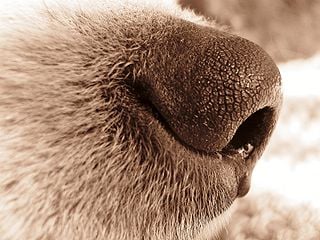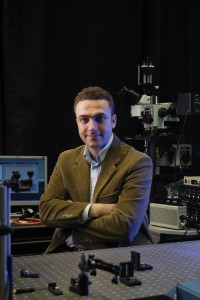You might expect the barrage of brilliant lab-on-a-cell-phone inventions that come out of the Ozcan Nano/Bio Photonics Lab at the University of California Los Angeles to eventually dwindle, or perhaps only leave us moderately impressed after a while, but that's not the case. Less than three weeks into 2013, the Ozcan Research Group published on their development of a new optical microscopy platform which uses liquid nanolenses that self-assemble around tiny objects (in the sub–100-nanometer range), allowing it to detect viruses and nanoparticles. That paper was published online in the journal Nature Photonics and was the subject of a recent UCLA research news release. Also this month, the Royal Society of Chemistry published the paper Cost-effective and Rapid Blood Analysis on a Cell-phone. And the international society for optics and photonics, SPIE, announced a new annual award for 2013: the Biophotonics Technology Innovator Award. One guess who its first recipient is? Not a shabby way to start the new year at all.
Tags: 2014, CA, University of California Los Angeles, 2013, Photonics, Ozcan Nano/Bio Photonics Lab, Microscopy, Lab-on-a-chip Technology, Southwest, California, University of California, Los Angeles, LAVS, UCLA, Biotechnology Vendor Showcase
 Yesterday we looked at two biologically inspired engineering experiments out of the Wyss Institute in Boston. Today we're on the West Coast at the University of California Santa Barbara's Institute for Collaborative Biotechnologies (ICB) marvelling over another technology that takes its cue from the biological world. It's a microfluidics device designed to function much like the super-sensitive nose of a dog, and it's already being commercialized for use in bomb detection, though other applications could include bio/chemical detection in industrial and healthcare settings as well. Results of the research gauging bomb detection accuracy specifically were published recently in an article in the journal Analytical Chemistry.
Yesterday we looked at two biologically inspired engineering experiments out of the Wyss Institute in Boston. Today we're on the West Coast at the University of California Santa Barbara's Institute for Collaborative Biotechnologies (ICB) marvelling over another technology that takes its cue from the biological world. It's a microfluidics device designed to function much like the super-sensitive nose of a dog, and it's already being commercialized for use in bomb detection, though other applications could include bio/chemical detection in industrial and healthcare settings as well. Results of the research gauging bomb detection accuracy specifically were published recently in an article in the journal Analytical Chemistry.
Tags: CA, Lab-on-a-chip Technology, Southwest, California, 2012, University of California Santa Barbara, Biotechnology, Front Line event, UCSB, Santa Barbara
At the Wyss Institute for Biologically Inspired Engineering at Harvard University, in the Longwood medical neighborhood in Boston, researchers have reached a biotech milestone with tremendous potential for future drug testing and development. Instead of resorting to animals for testing, they may soon be using a simulated organ that lives on a chip. It has mechanical and biological (cellular) parts, and yes, it breathes, thanks to a vacuum system that pumps air through. The bio-inspired micro-device has gone through several tests recently to assess its accuracy in mimicking the human lung when bacteria or potentially toxic drugs are introduced. Results: Positive. The lung-on-a-chip replicates responses found in animal models and observations of human lung function. Indeed, because the device uses human lung and blood vessel cells, it acts may act more like a lung in a human body than lab animals.
Tags: Northeast, Lab-on-a-chip Technology, 2012, Massachusetts, Cancer, biological, Boston, BioResearch Product Faire Event, MA, Harvard, innovative solutions, Drug Development, Harvard Medical School, bio medical research
In 1962, the Seattle World's Fair was held in the northwestern capital city. The legacy of that event goes well beyond the iconic Seattle Space Needle (right) and is explored in a panoply of summer and fall educational and entertainment festivities celebrating the 50th Anniversary. One of the "Next50" happenings is an interactive exhibit to highlight the role of Washington State's life science research innovations in addressing global health challenges. If space exploration was the governing dream of the near future in the 1960's, our generation's overriding fascination may be with possibilties inherent in life science research discoveries and their applications for transforming the health of millions of people worldwide in order to lead fuller, longer lives.
Tags: UW, University of Washington, Northwest, Lab-on-a-chip Technology, 2012, science event, Event, Front Line event, science current event, Seattle, bioscience event, Science research hub, scientist solutions, Exhibit space
Tags: University of California Los Angeles, Medical Device Technology, Ozcan Nano/Bio Photonics Lab, crowdsourcing, Microscopy, Lab-on-a-chip Technology, Southwest, Los Angeles, UCLA, innovative solution, Biotechnology Vendor Showcase, BVS
Tags: University of California San Diego, Bioscience research, cell biology, Lab-on-a-chip Technology, Southwest, California
 By now you've probably heard of "lab-on-a-chip" technology, where engineers take a lab analysis process that once required, well, a lab, and make it possible to run that analysis on a handheld smartphone device. Results are generated in real time, cheaper, and without bulky equipment. In this case, Michigan State University (MSU) plant pathologists are using the device in a field of vegetables under attack by pathogens.
By now you've probably heard of "lab-on-a-chip" technology, where engineers take a lab analysis process that once required, well, a lab, and make it possible to run that analysis on a handheld smartphone device. Results are generated in real time, cheaper, and without bulky equipment. In this case, Michigan State University (MSU) plant pathologists are using the device in a field of vegetables under attack by pathogens.
Tags: Michigan State University, Midwest, Lab-on-a-chip Technology, Michigan, Plant science
 The ubiquity of cell phone technology in today's world, even in developing nations, has opened a door for biomedical researchers to invent diagnostic devices that utilize the cell phone platform to perform analyses that otherwise would require prohibitively expensive equipment. And that is just what the 32-year-old bioengineering prodigy Aydogan Ozcan is doing at UCLA's Biophotonics Lab (also known as the Ozcan Research Group Nano / Bio Photonics Lab, and contributor of the photo at right) in the Samueli School of Engineering and Applied Sciences.
The ubiquity of cell phone technology in today's world, even in developing nations, has opened a door for biomedical researchers to invent diagnostic devices that utilize the cell phone platform to perform analyses that otherwise would require prohibitively expensive equipment. And that is just what the 32-year-old bioengineering prodigy Aydogan Ozcan is doing at UCLA's Biophotonics Lab (also known as the Ozcan Research Group Nano / Bio Photonics Lab, and contributor of the photo at right) in the Samueli School of Engineering and Applied Sciences.
Tags: University of California Los Angeles, Photonics, Ozcan Nano/Bio Photonics Lab, Lab-on-a-chip Technology, flow cytometry, California, Southwest Region

